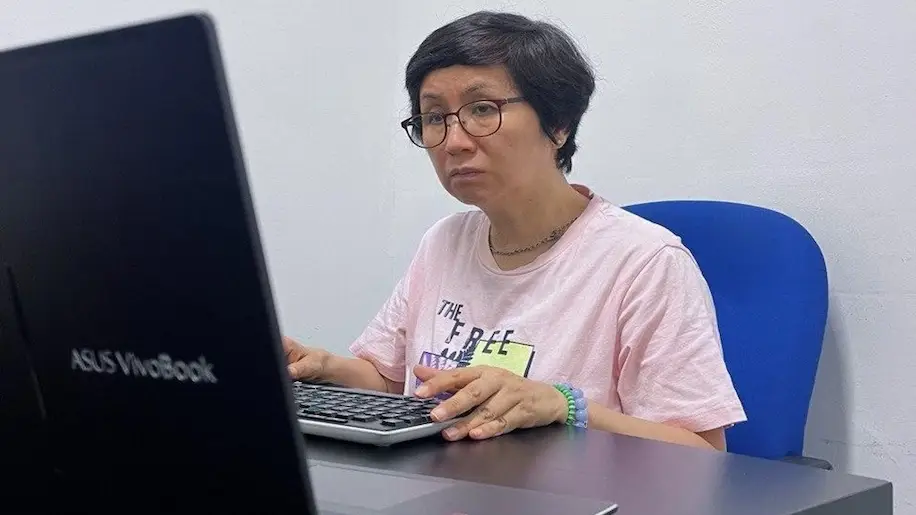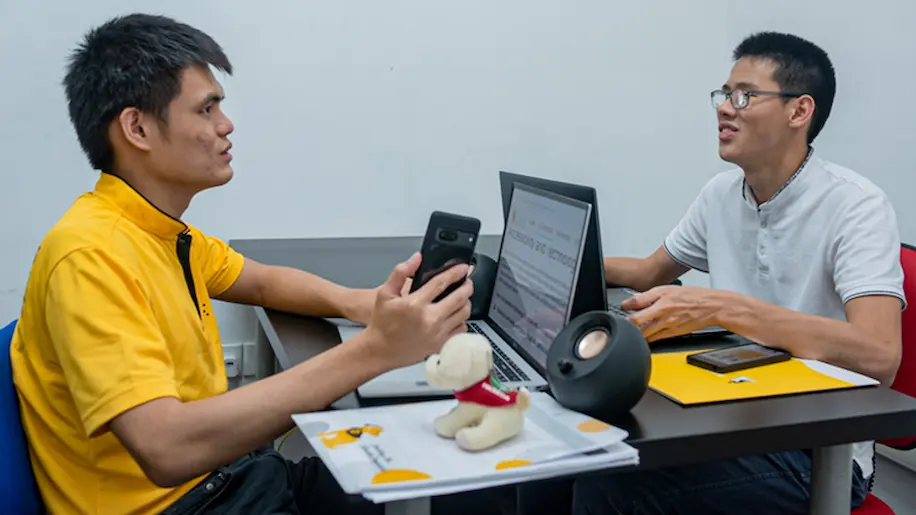The challenges faced by visually impaired individuals can be overwhelming, especially if they do not have access to help and support.
Pei Yueng first discovered that her vision was failing when it took her longer to do things that she used to be able to handle. However, that did not deter her from acquiring new digital knowledge and skills. She was introduced to Guide Dogs Singapore (GDS) and met Hong Sen, GDS’s IT Trainer and Consultant who helped her regain her confidence, tapping on technology to improve her quality of life.
A Lifeline to Digital Accessibility
The idea of the Smartphone Training Toolkit originated from the need to offer accessible and effective training resources for users who face challenges in navigating digital devices without sight.
The collaboration between the Singapore Institute of Technology (SIT) and Guide Dogs Singapore was an ideal match, as it leveraged SIT’s strength in applied research to gather data from trainers in different countries and GDS’s clients to give input on their needs and challenges. The result? A co-designed toolkit with relevant and practical curriculum, tailored to address the difficulties faced by the visually impaired community.
The second phase of the development involved a thorough evaluation of the toolkit by SIT, including stakeholders such as trainers and individuals who were taught to use the smartphone’s low vision accessibility features with this toolkit. Feedback collected from test users at GDS were then used to refine and enhance the toolkit.
The curriculum of the smartphone training toolkit is tailored not only for individuals with vision impairment but also for trainers, family, and support persons. Resources for trainers included techniques for understanding the specific needs of users and tips for effective training to enhance the learning experience and engagement. For families and support persons, resources focused on practical ways to provide assistance, essential skills for caregivers to learn, as well as useful insights from other visually impaired individuals.
A Beacon of Hope for the Visually Impaired
Learning assistive digital skills significantly enhances the daily living of individuals with vision impairment by promoting greater independence and self-sufficiency. Understanding smartphone settings, gestures, and accessible apps enables users to perform daily tasks more easily.
For Sherriza, a client of Guide Dogs Singapore, the toolkit opened up a new world that she never thought was possible and enhanced her ability to navigate her daily life independently as she became more proficient with her digital device.
Sherriza shared, “I cried when I finally learned how to use the VoiceOver function on my iPhone. When I first started, I was not used to a touchscreen phone. The gestures and terms used were unfamiliar to me. With practice, the smartphone became my key to independence.” Her brother, who was her pillar of support, realised her frustration during the learning process and took time to learn how to use VoiceOver himself using the toolkit. He then patiently taught her how to execute each gesture and the desired action associated with it.

Pei Yueng learned how to use assistive technology like screen readers
Another GDS client, Pei Yueng who has lost her vision at a much later stage in life, shared how the 1-1 accessibility and technology training helped to make her daily life easier and regained her confidence in life. She said, "Thanks to GDS, I learned to use assistive technology like screen readers. These tools now help me navigate apps, manage emails, do internet banking, and shop online with ease. Before, I had to strain my eyes, making these tasks exhausting. Now, I can comfortably handle them, continue supporting my family, such as ordering dinner for my parents, and staying connected with loved ones through WhatsApp."
Increasing The Reach to Support More Beneficiaries
While the project has benefited a significant number of individuals, GDS is committed to expand its reach and help more visually impaired users.
Since its launch, the toolkit has been extended to other Social Service Agencies such as the Singapore Association of the Visually Handicapped (SAVH) and iC2 Prephouse. It has also been adopted by hospitals such as the Singapore National Eye Centre (SNEC), Tan Tock Seng Hospital (TTSH), Ng Teng Fong General Hospital (NTFGH), Jurong Community Hospital (JCH), and Sengkang General Hospital (SKH).
“Digital literacy has always been one of the key areas that Guide Dogs Singapore champions as part of our mission to empower. We are extremely delighted to work alongside like-minded partners through the Digital for Life movement and to contribute to the wider community.” shared Hong Sen, Trainer and Consultant, of the Accessibility and Technology department at Guide Dogs Singapore. The funding from the Digital for Life (DfL) movement has been instrumental in making this project a reality. “Digital for Life has made it possible for us to engage participants with live experience as co-designers for this project. The funding helped us to build and design the web-based toolkit professionally, ensuring that it is accessible to the public, both with and without vision impairment, at no cost for the use of the toolkit.”, added Hong Sen.
Guide Dogs Singapore is constantly seeking opportunities to reach more learners by making training and support accessible, reducing learning barriers, and increasing resource availability. Some of the learners who have acquired the knowledge have also become volunteers, playing it forward to teach others.
To further enhance the experience of users of the toolkit, GDS hopes to broaden the scope of the training to include users’ feedback gathered during the evaluation phase, such as providing translation into vernacular languages and expansion into more advanced topics covered
Join the Digital for Life Movement and Contribute to Building a Digitally Inclusive Society
The “Enabling the Vision Impaired Through Technology” programme by Guide Dogs Singapore seeks to provide a supportive and nurturing learning environment for visually impaired individuals to adopt digital technology to enhance everyday living.
Visit https://guidedogs.org.sg/ to learn more about how Guide Dogs Singapore is supporting the visually impaired community.
Join the Digital for Life movement by starting a project and find out how the Digital for Life Fund can support you at https://www.digitalforlife.gov.sg/Contribute/Start-a-Project.












